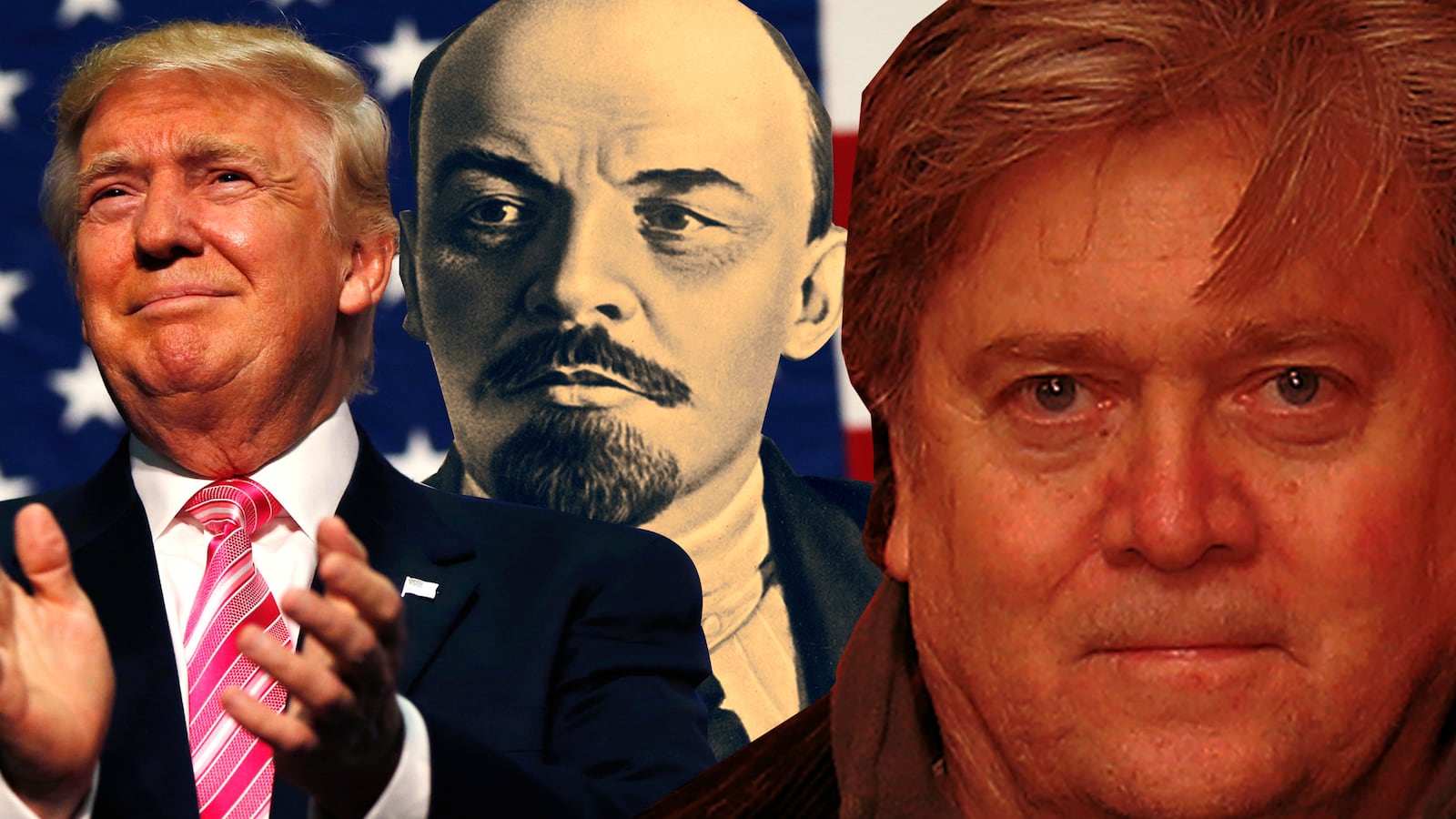Why has the Trump campaign taken as its new head a self-described Leninist?
I met Steve Bannon—the executive director of Breitbart.com who’s now become the chief executive of the Trump campaign, replacing the newly resigned Paul Manafort—at a book party held in his Capitol Hill townhouse on Nov. 12, 2013. We were standing next to a picture of his daughter, a West Point graduate, who at the time was a lieutenant in the 101 Airborne Division serving in Iraq. The picture was notable because she was sitting on what was once Saddam Hussein’s gold throne with a machine gun on her lap. “I’m very proud of her,” Bannon said.
Then we had a long talk about his approach to politics. He never called himself a “populist” or an “American nationalist,” as so many think of him today. “I’m a Leninist,” Bannon proudly proclaimed.
Shocked, I asked him what he meant.
“Lenin,” he answered, “wanted to destroy the state, and that’s my goal too. I want to bring everything crashing down, and destroy all of today’s establishment.” Bannon was employing Lenin’s strategy for Tea Party populist goals. He included in that group the Republican and Democratic Parties, as well as the traditional conservative press.
I emailed Bannon last week recalling our conversation, telling him that I planned to write about it and asking him if he wanted to comment on or correct my account of it. He responded:
“I don’t remember meeting you and don’t remember the conversation. And as u can tell from the past few days I am not doing media.”
Riding on the Metro to the party, I read an article that had just been posted on National Review Online and in TownHall.com by Thomas Sowell, the conservative economist, in which he opposed the tactics used by the Tea Party in shutting down the government. He favored the intent of the Tea Party, but strongly opposed its tactics. "The only question," he wrote, "is about the tactics, the Tea Party's attempt to defund Obamacare." Their actions did not fit the standard set by Edmund Burke, he wrote, of a "rational endeavour." There was no chance of making a dent in ObamaCare or defunding it when Democrats controlled the Senate. and the public created a "backlash against that futile attempt," so that "there was virtually nothing to gain politically and much to lose."
I then asked Bannon whether or not he had read Sowell's piece, since Bannon was in favor of the very Tea Party tactic that Sowell had criticized.
“National Review and The Weekly Standard,” he said, “are both left-wing magazines, and I want to destroy them also.” He added that “no one reads them or cares what they say.” His goal was to bring down the entire establishment including the leaders of the Republican Party in Congress. He went on to tell me that he was the East Coast coordinator of all the Tea Party groups. His plan was to get its candidates nominated on the Republican ticket, and then to back campaigns that they could win. Then, Bannon said, when elected they would be held accountable to fight for the agenda he and the Tea Party stood for.
If they didn’t, “we would force them out of office and oppose them when the next election for their seats came around.”
That, essentially, was the tactic employed when Eric Cantor was ousted by a far right candidate, virtually unknown college economics professor Dave Brat, in his Virginia district’s primary. It was also the path Donald Trump’s supporters took in Wisconsin, when hoping to duplicate their successful tactics in Virginia, they ran a candidate in the Wisconsin Republican primary against Speaker Paul Ryan in his own district. There are a few Republicans that Bannon does respect. One of them is Rep. Louis Gohmert, the fiery congressman from Texas, who was also at the party. Gohmert, who is part of the self-proclaimed anti-establishment wing of the Republican Party, was an ally of Cruz in the government shutdown.
Trump’s decision to take on Bannon indicates that he wants to wage his campaign along the lines laid down by him—that of destroying the Republican leadership and the Party as we know it. Trump’s behavior thus far has been compatible with Bannon’s belief in Leninist tactics. As the Bolshevik leader once said, “The art of any propagandist and agitator consists in his ability to find the best means of influencing any given audience, by presenting a definite truth, in such a way as to make it most convincing, most easy to digest, most graphic, and most strongly impressive.”
Only one question remains. Knowing this, why do leaders like Paul Ryan, Mitch McConnell, and others, who regularly condemn Trump’s statements but yet still endorse him, stick with such a self-defeating approach? They will only end up helping Bannon and company cast them into oblivion and finish their hostile take-over of the GOP.
Editor's Note: This article has been updated to reflect when the party took place, and which Thomas Sowell article was discussed at it.





